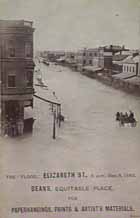Elizabeth Street was once the boundary between two Melbournes, being the main exit from Melbourne to the goldfields along Mt Alexander Road, and an entry to Flinders Street Station at its southern end. It was also a social boundary, marking off the business end of town from the retail centre.
Built on the site of an old creek bed, Elizabeth Street, prior to the installation of storm-water drains, was often a site of serious flooding. At times the street was in need of a punt system to cross, such as the joke in one 1839 paper: “Tenders will be received until the 1st of December by parties willing to contract for the establishment of a ferry over the lower parts of Collins and the middle of Elizabeth streets, the state of which in rainy weather renders these impassible without the means of a punt”. Wooden crossings over main streets were often constructed, with many a pedestrian and horse becoming stuck in the mud.
The east corner of Collins and Elizabeth Streets was the site of the Melbourne Waterworks Company’s first sunk well in 1840. Owned by private water sellers, apart from rain water, it was the only supply of water in Melbourne, with sellers trading from horse-drawn watercarts making regular deliveries. The water was, however, notoriously unhealthy, as buildings and factories spread upstream and their drains emptied into the Yarra, not to mention the slaughter houses below the Falls, which resulted in typhoid fever and other water-borne diseases.



